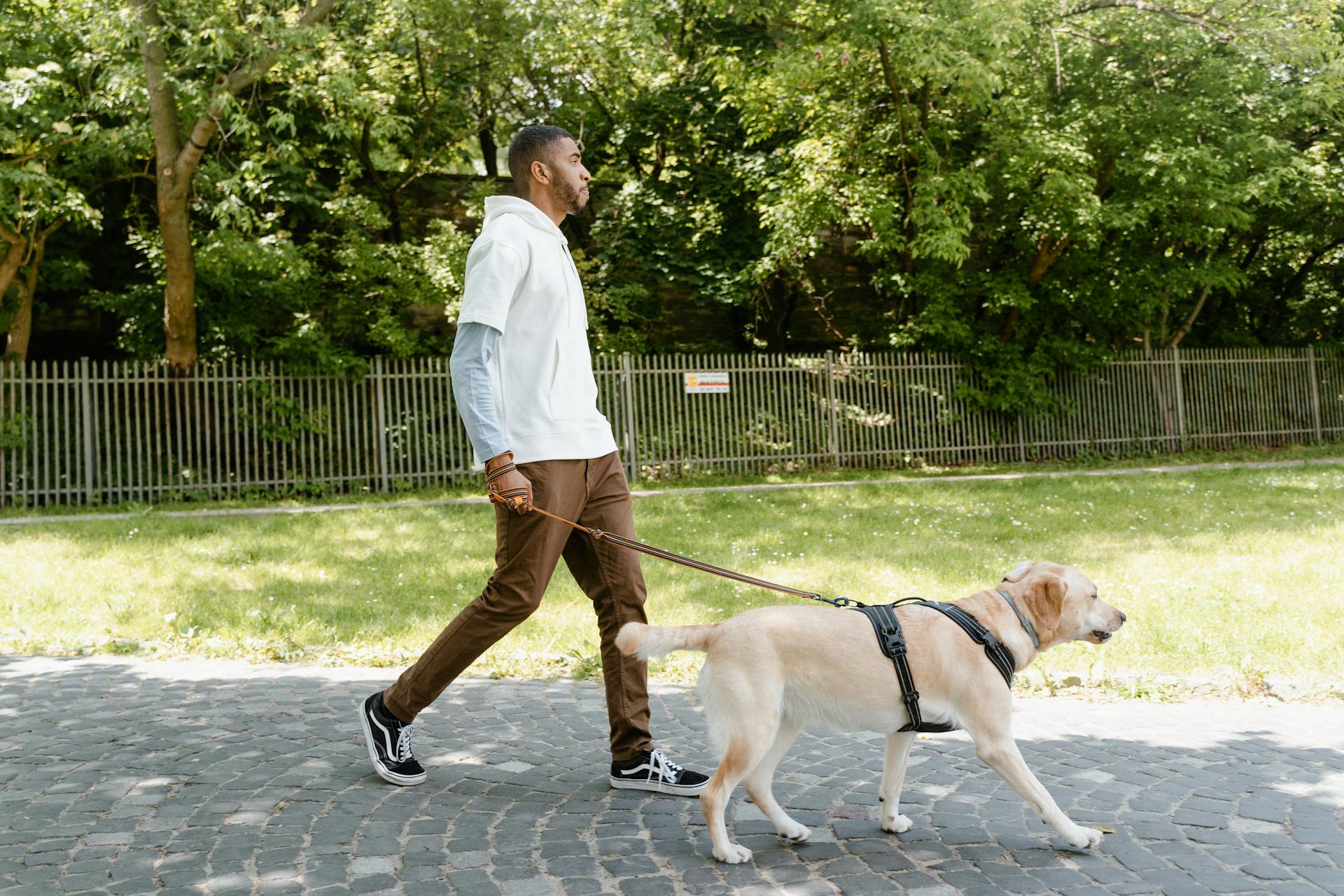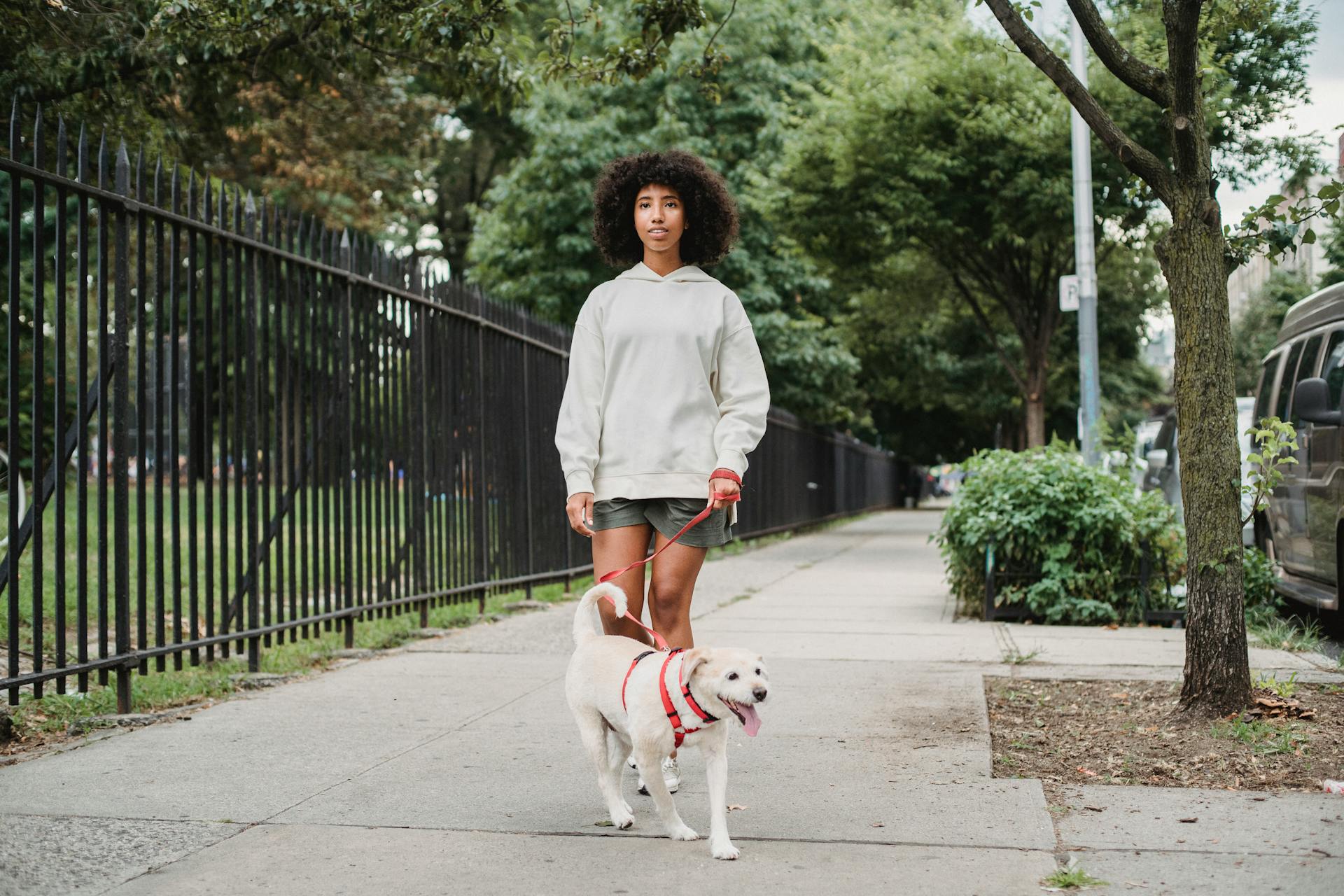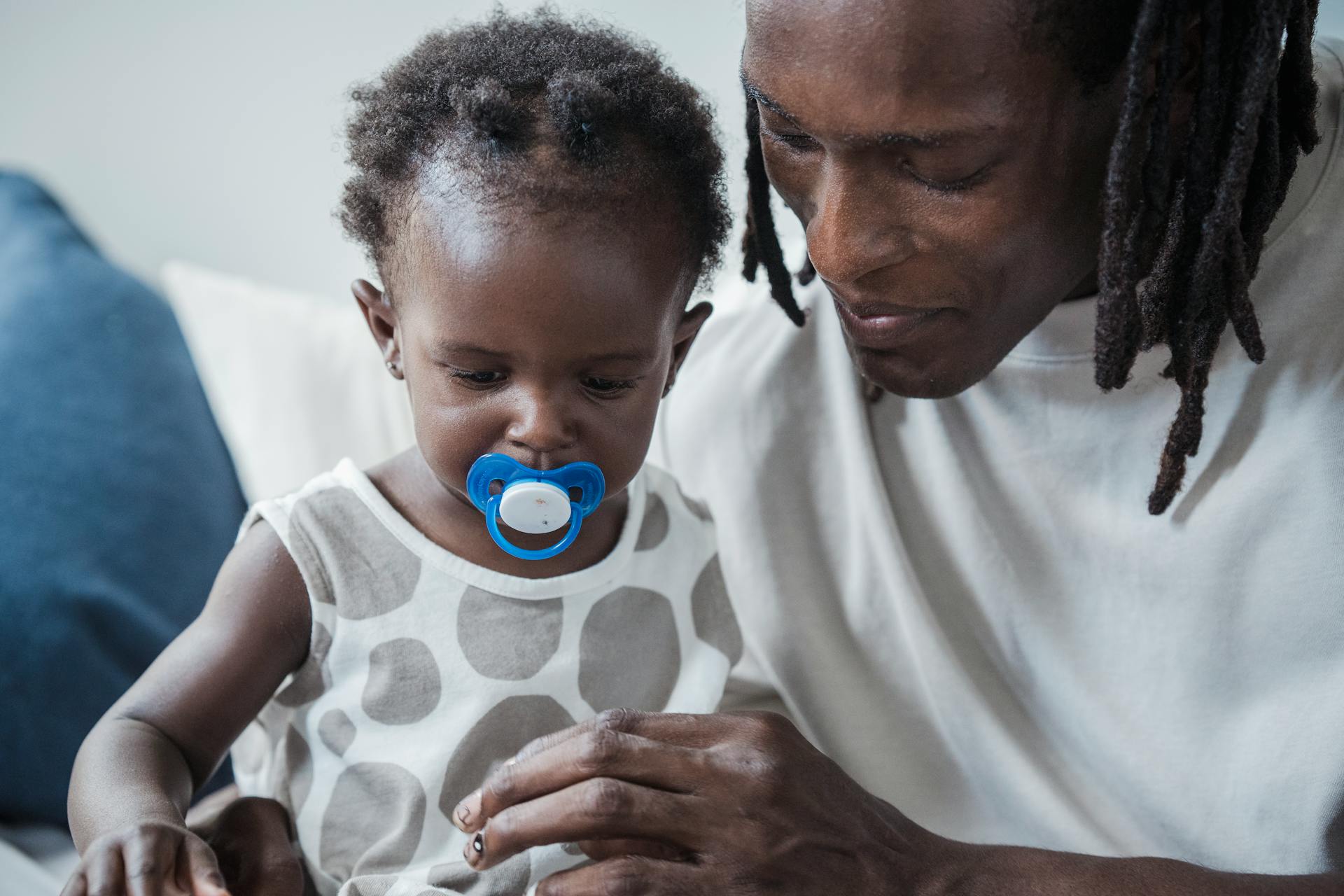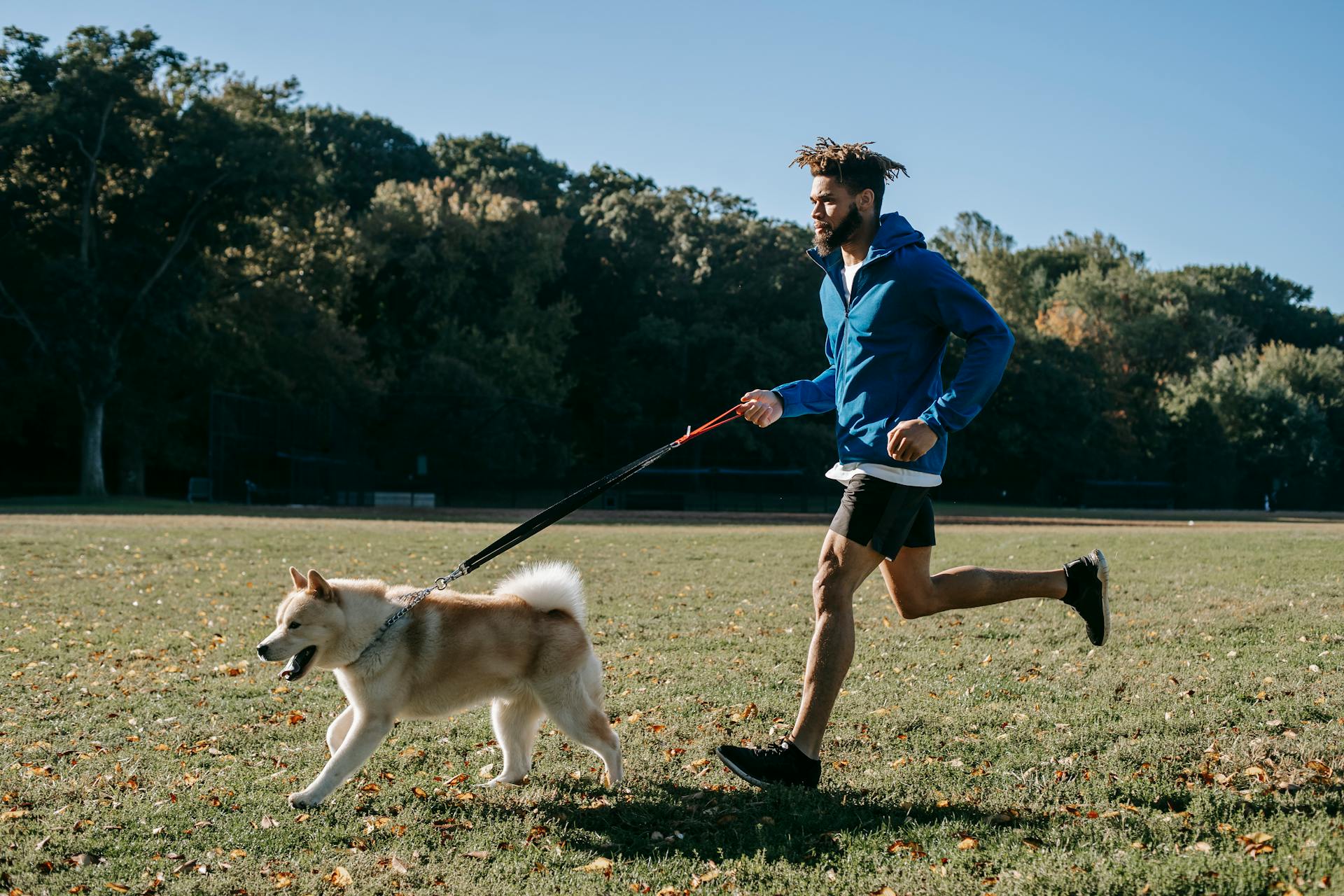
The human-canine bond is a truly special thing. Studies have shown that dogs are able to form strong emotional bonds with their owners, often on a par with those of human relationships.
Dogs are able to pick up on our emotions, and have even been known to recognize and respond to our emotional states. This is because they are highly attuned to our body language and vocal cues.
Oxytocin, often referred to as the "cuddle hormone", is released in both humans and dogs during interactions that promote bonding, such as play or affection. This hormone helps to strengthen the bond between us and our canine companions.
In many ways, our relationships with dogs are similar to those with other humans - we form attachments, experience joy and companionship, and even grieve when they're gone.
Recommended read: How to Bond with Your Bird?
The Human-Canine Relationship
The human-canine relationship is a remarkable bond that has evolved over thousands of years. It's a testament to the power of companionship, love, and mutual respect.
Dogs were initially domesticated around 15,000 years ago, marking a pivotal moment in the evolution of this bond. They adapted to human lifestyles, from nomadic to settled agricultural communities, and were selectively bred to meet human needs and preferences.
The relationship between humans and dogs began as a working relationship, with dogs providing services like hunting and herding. They also served as guards and companions, using their strong senses to detect potential dangers.
Today, dogs continue to provide various services, including acting as certified service dogs, emotional support animals, and simple companions. They're valued members of our families, sharing our homes, hearts, and adventures.
Studies have shown that dogs benefit from interacting with humans, reducing stress and promoting a sense of attachment. In fact, shelter dogs have been found to experience a reduction in plasma cortisol levels after interacting with complete strangers.
The bond between humans and dogs is a bidirectional attachment bond, similar to that of a human caretaker and infant. This bond is characterized by proximity seeking behavior, safe haven effect, and the ability to assess humans' emotional states.
Upon loss, caregivers often experience intense feelings of grief, demonstrating the deep emotional connection between humans and dogs.
Here are some examples of roles dogs have played throughout history:
- Guard dog
- Attack dog
- Mascot dog
- Detection dog
- Law Enforcement dog
Benefits of Dog Ownership
Owning a dog can have a profound impact on your mental and emotional well-being. Studies show that owning a dog reduces stress and alleviates anxiety.
Dogs can provide a sense of purpose and routine, helping you develop a daily schedule and giving you something to look forward to each day. This can be especially beneficial for those who tend to be more isolated, such as children with no siblings or elderly persons.
The bond between humans and dogs is rooted in their shared pack animal nature, encouraging social symbiosis and strong social bonds. Dogs become reliant on their humans for affection and protection, forming a deep connection that's essential for their overall well-being.
As a household pet, dogs can bring numerous benefits, including a strengthened human-canine bond. This is often reported by American dog owners, who feel that their dog is a member of their family.
In fact, many owners allow their dogs to sleep in their beds with them, which can lead to lessened anxiety and a more peaceful sleep.
You might like: How to Bond with Your Ferret?
Training and Obedience
Training and obedience play a crucial role in nurturing a strong and harmonious relationship between humans and their canine companions.
Clear and consistent communication is essential for effective training, helping to build trust and reinforce desired behaviors while addressing unwanted behaviors positively and constructively.
Positive reinforcement techniques, such as praise, treats, and play, serve as powerful motivators for dogs, encouraging them to engage enthusiastically in the training process.
Through the process of training, humans and dogs form a deep bond based on mutual understanding and cooperation.
Structured activities like agility, obedience trials, and canine sports provide valuable opportunities for bonding and teamwork between humans and dogs.
These shared experiences deepen the bond between humans and dogs, as they learn to anticipate each other's actions and communicate effectively as a team.
The sense of accomplishment and pride that comes from mastering new skills together further cements the bond between humans and dogs.
A different take: Dog Play Daycare
By rewarding desired behaviors, we communicate to our dogs what we expect from them and reinforce their efforts to comply, fostering a sense of confidence and self-assurance in the dog.
Dogs are highly adaptable and may adjust to their humans' personalities, especially if they become part of the family as puppies.
Shared Activities and Recreations
Shared activities and recreational pursuits are a great way to strengthen the human-canine bond. From leisurely walks to outdoor adventures, engaging in activities together fosters a deeper connection built on shared experiences and mutual enjoyment.
Walking, in particular, provides valuable opportunities for bonding and exploration. Whether it's a brisk morning stroll or a leisurely meander, walking allows us to share in the simple pleasure of being in each other's company.
Herding
Herding is a unique activity that requires a special set of skills, which herding dogs have evolved over time. Herding dogs have been working alongside humans for thousands of years, roughly since the domestication of sheep.
Herding dogs have developed a range of traits and mannerisms that make them ideal for the job. They rely on posture and eye contact rather than brute force to manage the herd.
The cattle dog is a prime example of a herding dog, with a long history of working with humans. Today's herding dogs can be categorized into several types, including protectors, drivers, headers, and heelers.
Hunting
Hunting has been a shared activity between humans and dogs for thousands of years, with cave art from over 9,000 years ago depicting dogs being used for hunting.
Dogs have been involved in hunting in various ways, with three main categories: Terriers, gun dogs, and hounds. Terriers are smaller dogs used to hunt small animals like birds and rabbits.
Gun dogs are typically used during upland and wetland hunting to retrieve downed game, while hounds specialize in the chase and use various noises to flush out larger mammals like deer, coyote, boar, and foxes.
Readers also liked: Famous Yorkshire Terriers

In fact, hounds are often used to hunt larger mammals, relying on their unique characteristics to track and pursue their prey.
Dogs have been an essential part of hunting for centuries, and their roles continue to evolve to this day, making them an invaluable companion for hunters around the world.
Shared Activities and Recreations
Shared activities and recreational pursuits are a great way to strengthen the bond between humans and dogs. From strolls in the park to outdoor adventures, engaging in activities together is a simple yet effective way to build a deeper connection.
Walking is one of the simplest yet most cherished shared activities between humans and dogs. Whether it's a brisk morning stroll or a leisurely meander, walking provides valuable opportunities for bonding and exploration.
Outdoor adventures offer boundless opportunities for exploration and excitement. Hiking, camping, and backpacking are popular pursuits among outdoor enthusiasts and their canine companions, providing opportunities to immerse ourselves in the beauty of nature.
Canine sports and activities are a great way to challenge dogs physically and mentally, while providing valuable opportunities for bonding and socialization. From agility and flyball to obedience trials and dock diving, these activities challenge dogs to work together with their humans.
Shared hobbies and interests can also strengthen the bond between humans and dogs. Whether it's participating in art projects, attending training classes, or simply lounging together with a good book, finding activities that both humans and dogs enjoy can create moments of connection and relaxation.
Socialization with Dogs
Dogs are highly social animals who become reliant on their humans for affection and protection. They can form strong social bonds with humans, which is essential for their overall well-being.
Both humans and dogs are pack animals, and they need to engage in caregiving relationships with others to feel connected. Dogs prefer to connect with others, and they can be perfectly content in a relationship with humans, even when isolated from others of their own kind.
Dogs can function and be happy in a relationship with humans, which is a testament to the strength of the human-canine bond. This bond is built on trust, affection, and mutual care.
People with mental health conditions, such as depression and isolation, may find comfort in the companionship of an emotional support animal. These animals don't require specific training, but they can provide comfort and affection to those in need.
The human-canine bond is a two-way street, where both humans and dogs benefit from each other's company. By engaging in social symbiosis with dogs, humans can feel less isolated and more connected to others.
Explore further: Reptiles Bond
Research and Intelligence
Research has shown that dogs are capable of detecting human emotions, thanks to their highly developed sense of smell.
Boris M. Levinson accidentally discovered the benefits of assisted pet therapy, finding that withdrawn children interacted positively with his dog, Jingles, during therapy sessions.
Dogs have come a long way from being just household pets, with many now working in fields such as explosive detection, therapy, and invasive species detection.
Their strong sense of smell allows them to perform these jobs safely and efficiently, and a strong bond between the dog and handler is essential for success.
In fact, research has shown that dogs can even understand human emotions, making them invaluable companions for people in need.
Consider reading: Therapy German Shepherds
Search
Dogs have been used for search and rescue operations for centuries, with the first search and rescue dogs being the Saint Bernards who were trained to locate lost or stranded travelers in the Swiss Alps.
Their highly developed sense of smell allows them to detect a wide range of scents, including drugs, invasive species, and people.
Dogs and their handlers form a close bond, which enables them to interpret each other's body language correctly, leading to successful detection.
Examples of body language to look for when a dog begins to "hit" on a scent cone include small pauses, tail flicks, and puffing air with the nose.
Every dog is different and will present different signals that require dedicated training from the handler to learn how to correctly interpret.
- Small pauses, tail flicks, and puffing air with the nose are examples of body language to look for when a dog begins to "hit" on a scent cone.
- Dedicated training is required to learn how to correctly interpret a dog's unique signals.
Research
Research has a fascinating history, and it's amazing to see how it has evolved over time. Boris M. Levinson accidentally discovered the benefits of assisted pet therapy, finding that children would interact positively with his dog Jingles during therapy sessions.
Expand your knowledge: Therapy Dog Golden Retriever

Levinson's discovery was reinforced by Sam and Elizabeth Corson, who researched and evaluated pet-facilitated therapy. They were among the first to study the human-animal bond in a scientific way.
The term 'human-animal bond' was officially coined by Leo K. Bustad in the early 1980s. Bustad delivered a summary lecture on the Human-Pet Relationship at the International Symposium in Vienna, where he praised Konrad Lorenz's work on the subject.
Bustad and other pet therapy advocates formed the Delta Society, building on the earlier work of Levinson and Corson. This marked a significant step forward in recognizing the importance of the human-animal bond.
Today, dogs are used in a wide range of jobs, from explosive detection to therapy and invasive species detection. Their highly developed sense of smell makes them ideal for these tasks.
Intelligence
Intelligence plays a vital role in the dog-human bond. Dogs and humans communicate, and many humans understand "dog" better than they may first think.

Many humans are familiar with the signs of a friendly dog or a frightened one. They can often pick up on subtle cues like body language and tone of voice.
Dog owners generally become very aware of their pets' signals for "play with me" or any signals their dog might be in pain. This understanding is crucial for building trust and a strong bond between dog and owner.
Dogs often come to understand people over time. With training and exposure to regular human interaction, they can learn to recognize and respond to specific words and commands.
Training can teach dogs to understand specific human commands, especially with the help of delicious treats. This process can be rewarding and fun for both dog and owner.
For another approach, see: How Often Can You Put Flea Medicine on a Dog
Introduction and Conclusion
The human-canine bond is a remarkable connection that can bring immense joy and companionship into our lives. This bond is built on loyalty, love, and a deep understanding between humans and dogs.
Challenges are an inevitable part of this journey, but they can also be opportunities for growth and strengthening of the bond. By facing obstacles with patience and empathy, humans and dogs can emerge stronger and more connected than ever before.
The strength of the human-canine bond is not defined by the absence of challenges, but by the resilience and dedication with which we face them.
Introduction
Dogs have been woven into the fabric of our lives as deeply as any family member, thanks to their unwavering loyalty and boundless affection.
The human-canine bond is a profound connection rooted in millennia of shared history and mutual dependence. This bond has evolved alongside us, from ancient hunting partnerships to modern emotional support and companionship.
Dogs have become more than just pets, they're cherished members of our families and steadfast companions on life's journey. They've transcended mere cohabitation, becoming an integral part of our lives.
From the psychological and emotional benefits of dog ownership to the nuances of communication and understanding between species, the human-canine bond is a multifaceted connection. It's a relationship that enriches our lives in ways both profound and immeasurable.
Additional reading: Emotional Intelligence of Dogs
Conclusion
The human-canine bond is a truly unique and special thing, and it's not the absence of challenges that defines its strength, but rather the resilience and dedication with which we face them.
Challenges are an inevitable part of the journey, but they're also an opportunity for growth and deepening our connection with our canine companions.
It's through moments of frustration and triumph alike that the bond between humans and dogs remains steadfast, a beacon of unwavering loyalty and unconditional love.
This resilience and devotion is what defines the enduring beauty of the human-canine bond, and it's a reminder that our relationship with our dogs is a journey of mutual understanding, companionship, and growth.
The bond between humans and dogs transcends species and enriches our lives in ways we could have never imagined, making it truly unforgettable.
Sources
- https://en.wikipedia.org/wiki/Human%E2%80%93canine_bond
- https://medium.com/@ethan40008/the-human-canine-bond-exploring-the-profound-connection-between-humans-and-dogs-c25cac621d0c
- https://www.wikiwand.com/en/Human%E2%80%93canine_bond
- https://animalsmatter.com/blogs/news/dog-science-series-the-science-behind-the-human-canine-bond
- https://www.ncbi.nlm.nih.gov/pmc/articles/PMC6713833/
Featured Images: pexels.com


